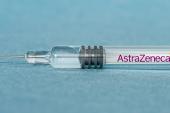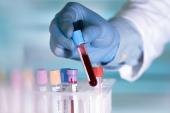CVST Risk Far Lower With Viral-Vector Vaccines Than With COVID-19 Itself
The updated estimates can help in discussions with patients about the risks and benefits of adenovirus-based vaccination.

Cerebral venous sinus thrombosis (CVST), a manifestation of vaccine-induced immune thrombotic thrombocytopenia (VITT), is much more likely to be observed in patients hospitalized with COVID-19 than in people who have received one of the adenovirus-based COVID-19 vaccines, according to new estimates.
Through the middle of April 2021, the rate of CVST after receipt of the Oxford/AstraZeneca vaccine in the United Kingdom was 3.6 per million and the rate following receipt of Johnson & Johnson’s Janssen shot in the United States was 0.9 per million, researchers led by Behnood Bikdeli, MD (Brigham and Women’s Hospital, Boston, MA), report.
Those figures are markedly lower than the CVST rate of 207 per million patients hospitalized with COVID-19, a number estimated using an analysis of the Society of Vascular and Interventional Neurology (SVIN) COVID-19 Registry. Vaccinees had a CVST rate roughly comparable to the estimated US background rate of 2.4 per million.
Reports of thrombotic events after COVID-19 vaccination first cropped up in countries that started rolling out the Oxford/AstraZeneca shot, mostly among younger women and in some cases accompanied by thrombocytopenia. This led to either changes in which groups were recommended to receive the vaccine or to temporary or permanent discontinuation of its use. Similar reports starting coming out of the United States once Johnson & Johnson’s Janssen vaccine was introduced, resulting in a temporary pause in that vaccine’s use (since lifted).
In that context, these new estimates for CVST following receipt of either of adenovirus-based vaccines may help people weigh the risks and benefits of vaccination.
“We are not here to tell people what to do or what not to do, but what’s critically important is for patients and clinicians and policy makers to have access to information in a way that they can use the data in shared decision-making,” Bikdeli told TCTMD. The analysis does not provide estimates in key subgroups, he acknowledged, “but at least having some information would be better than making an entirely arbitrary decision without objective information.”
These data are relatively consistent with previous studies and add to the existing literature by providing 99% confidence intervals around the estimates. “I think all in all these speak to the safety of the vaccines,” Bikdeli said. “It’s not an absolute, but relatively speaking they seem to be very safe with respect to the risk of thrombotic events.”
Andreas Greinacher, MD (Universitätsmedizin Greifswald, Germany), whose group described and coined the term VITT, commented on the findings for TCTMD, saying, “I’m a bit skeptical of these data, because they seem not to cover what is really going on.” He noted that the paper is taking a look specifically at CVST rather than the wider phenomenon of VITT, which occurs after receipt of one of the adenovirus-based vaccines at a rate of about 10 per million according to publicly available data in Europe.
Bikdeli acknowledged that the inability to provide detailed estimates of VITT is a limitation of the study. “We are not dismissive of the importance of VITT or the fact that it could have serious consequences,” he said. “This paper by itself is just trying to indicate that the absolute risk with the vaccine is very low for cerebral venous sinus thrombosis and in contrast, just descriptively speaking, the absolute risk for people with COVID-19 is a lot higher. So if you were to just go by the numbers you can have risk either way, but this risk is just a lot higher for people who do contract COVID-19 and we know for a fact vaccines are very effective against that.”
UK and US Data
The study, published online June 8, 2021, ahead of print in the Journal of the American College of Cardiology, used data from the UK Medicines and Healthcare products Regulatory Agency and the US Centers for Disease Control and Prevention (CDC) to estimate rates of CVST among people getting these vaccines; from the multinational SVIN registry to estimate rates in hospitalized COVID-19 patients; and from the Nationwide Inpatient Sample to calculate the monthly incidence of CVST in the US population in March and April 2018.
Bikdeli et al identified 77 CVST cases among 21.2 million people who received the Oxford/AstraZeneca vaccine and six cases among 6.85 million recipients of the Janssen shot. In the SVIN registry, three of 14,483 patients hospitalized with COVID-19 had CVST.
The study shows that the occurrence of CVST among vaccine recipients is “really not that impressively different from the normal population,” Bikdeli said.
The investigators acknowledge that the analysis is limited by several factors, including differences between data sources; the fact that the background US rate of CVST was calculated based on hospitalization and not incidence rates; the possible underreporting of events; and the lack of information related to CVST in people receiving one of the mRNA-based vaccines, like those from Pfizer/BioNTech and Moderna.
There is also no breakdown of the data according to key subgroups, including those defined by age.
“Additional research is required to fully elucidate the event rates, to understand the risk factors for vaccine-associated CVST and to identify strategies to prevent it,” the study authors conclude. “In the meantime, transparent realistic communication of the risk estimates will be helpful for shared decision-making between patients and clinicians.”
Weighing the Risks and Benefits
The American College of Cardiology (ACC) recently updated its website on what cardiovascular clinicians should know about VITT. Geoffrey Barnes, MD (University of Michigan, Ann Arbor), a member of the ACC’s Peripheral Vascular Disease Section, is the lead author of the guidance, which now incorporates information from the analysis from Bikdeli et al.
“I think this analysis helps to put into perspective the risk of this rare event, cerebral venous sinus thrombosis, in various groups,” Barnes told TCTMD, saying the difference in rates between hospitalized COVID-19 patients and vaccine recipients is striking.
“That is helpful, but I also think that we have to remember that VITT, the thrombotic thrombocytopenia syndrome, is not just about the clot,” he added. “It’s about having the clot and also having an autoimmune thrombocytopenia, or thrombocytopenia following the vaccine. And that’s what makes it an even more rare event and one of the reasons why I think the CDC was appropriate to do the pause on the vaccine when they first found out about it. And so I think this analysis is helpful to think about how often the clotting happens, but we can’t forget that the syndrome is clot plus thrombocytopenia, which really makes it a little bit more distinct.”
For Barnes, these new numbers doesn’t change the overall messages about COVID-19 vaccination. “It doesn’t change the messaging for me, because I’ve used the messaging that the vaccines are still safe,” he said, adding, however, that the study “does give some numbers to help have a conversation with patients.”
More detail about event rates in various age groups, not available in this study, would be helpful for such a discussion, Greinacher indicated, alluding to changes in the risks of COVID-19 itself and of vaccine-related adverse events across age groups. “If one looks overall in an entire population, the situation is relatively clear, but if it comes down to more-individualized risk assessments, then these data are not very helpful,” he said.
The balance between risks and benefits will also vary according to a country’s specific situation, particularly in regard to the availability of multiple vaccines, Greinacher said. People should be informed of the risk of VITT, but “in a privileged country where there is lots of access to other vaccines, one may balance the risks and benefits completely different in comparison to a country where you only have the adenovirus-based vaccines available,” he explained.
It is important to avoid scaring people away from COVID-19 vaccination, especially if either the Oxford/AstraZeneca or Johnson & Johnson shot is the only one available to them, Greinacher stressed. “If they are scared of being vaccinated, the overall death toll we pay and they pay because of a highly increased rate of COVID-19 disease is something every one of us needs to be aware of.”
Treating VITT
In addition to providing estimated rates of CVST in various populations, Bikdeli et al touch on emerging consensus around how to treat VITT when it occurs. Because of the condition’s similarity to heparin-induced thrombocytopenia, the recommendations say heparin should be avoided. “Some experts recommend the administration of intravenous immunoglobulin or corticosteroids in patients with CVST associated with thrombocytopenia and antibodies against platelet factor-4,” the authors write, citing advice from the American Heart Association/American Stroke Association published at the end of April.
A brief report published in the New England Journal of Medicine this week affirmed that administration of IV immunoglobulin reduced antibody-induced platelet activation in three Canadian patients with VITT after receipt of the Oxford/AstraZeneca vaccine.
Greinacher urged individuals who develop complications after vaccination to immediately contact their doctor. “Although this is only anecdotal cases, our impression at the moment is that those who wait too long until they seek medical help have a worse outcome than those who are treated immediately,” he said. “There’s no way to avoid VITT—it’s probably inherent to the adenovirus vaccines—but what one can do is to treat those who unfortunately suffer from the adverse vaccination reaction as soon as possible.”
VITT remains an area of active research, Bikdeli noted, pointing to efforts to understand triggers and risk factors. In addition, he said he’s working closely with RIETE, the world’s largest registry of venous thrombosis, to better understand venous thromboembolic events following vaccination.
“All of us remain enthusiastic and should continue to work hand in hand to generate more information about subgroups, risks, and outcomes if these complications were to happen and try to understand how we can mitigate patient outcomes if one of these blood clot complications were to occur after vaccination,” he said.
Todd Neale is the Associate News Editor for TCTMD and a Senior Medical Journalist. He got his start in journalism at …
Read Full BioSources
Bikdeli B, Chatterjee S, Arora S, et al. Cerebral venous sinus thrombosis in the US population, after adenovirus-based SARS-CoV-2 vaccination, and after COVID-19. J Am Coll Cardiol. 2021;Epub ahead of print.
Disclosures
- Bikdeli reports being a consulting expert, on behalf of the plaintiff, for litigation related to two specific brand models of IVC filters.





Comments